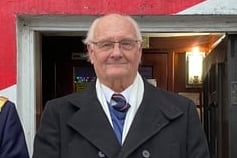Written by Barry Brooking
MOST of my generation were taught that in 1066 there was a Norman invasion of England which changed our country significantly. On June 6, 1944, 80 years ago, there was another important invasion - but this time in the other direction. Allied Forces invaded Normandy in North-Western Europe.
The objective was to liberate countries in Europe conquered by Nazi Germany in the Second World War by the establishing of a Second Front. Stalin had been calling for this, as Russia has been bearing the brunt of the fighting and incurring very heavy casualties against the Germans.
The assault on Normandy was a massive undertaking, against a fortified 'Atlantic Wall' stretching 3,000 miles from Norway to Spain. It was the biggest amphibious assault in history. It involved 2 years of meticulous planning, over 5,000 ships and vessels, and putting ashore 150,000 men in the first 24 hours. Its code name was 'Operation Overlord', and the day of the attack was called 'D-Day'. The combined sea, land and air operation involved courage, efficient and effective organisation, co-ordination and logistics management, and even deception and specially designed assault weapons of war.
It is recognised that amphibious assaults on a defended coast are the most hazardous of all large-scale military operations. The allies were only prepared to go when they were sure they were ready. On June 5 and 6 Allied troops left ports all along the South coast of England, including Plymouth, to attack five Normandy beaches, code named Utah, Omaha, Gold, Juno and Sword, US troops to the West, British and Canadian troops to the East.
Our area played an important part in preparation for D-Day. In April 1943, troops of the US 29th Division were transferred from Salisbury Plain to Devon and Cornwall. They were accommodated at Seaton, Plumer, Crownhill and Raglan Barracks, Plymouth. A unit of the 456th Battalion was stationed at Woodland Fort. Part of the unit guarded the training and supply camp set up in November 1943 and comprising nissen huts at Vicarage Road, St. Budeaux. They also guarded the Royal Albert Bridge. The camp dispensed 60,892 tons of invasion equipment over the period. It was de-commissioned in August 1945. There was a large military oil tank on Little Ash Farm, Saltash Passage.
Later on, temporary tented camps were set up around Plymouth for US Assault troops, including the Mount Edgcumbe Estate, and woodland on the Antony Estate, Torpoint. The troops embarked at Barn Pool. They trained on Dartmoor and Bodmin Moor, as British troops had done in WWI More realistic training was performed on places like Slapton Sands beach, using live ammunition.
From May 1944, 60,000 US troops were based in the Plymouth area just prior to D-Day. They were part of the one-million US troops in the country preparing for 'Operation Overlord''.
The 'Code Name' for the many US camps in the area was 'Sausages'. Accommodated troops were mainly serving in the 4th Division V and V11 Corps and 29th Division of the 1st Army, under General Omar Bradley.
Secrecy about the invasion was vital. The Germans knew that an invasion was coming, but not when or where. Saltash Passage was a restricted area from January 1944. Residents not only had the individual I.D. cards, but they also had to carry an additional yellow certificate of residence to prove they lived there. Visitors were escorted by Military Police.
On 5th and 6th June 1944, US assault troops left their camps around Saltash Passage and travelled along Tamar Terrace, St Budeaux, later re-named Normandy Way, and Vicarage Road, later re-named Normandy Hill. A concrete, sloping slipway or 'hard' was constructed by U.S. construction battalions for troop embarkation into landing craft. These were called 'Chocolate Box Hards' because of what they resembled.
A commemorative tablet was unveiled in 1947 to record Marshalling Area 'A' of U.S. Army Route 23, and a memorial plaque and garden was opened in 1958.
Because of the distance to be travelled to the West Normandy beaches, about 100 miles, Plymouth-based US troops were the first land-assault troops to leave England. 110 ships carried 36,000 troops of the US V and V11 corps, part of the 4th Infantry Division of the US 1st Army. Allied aircraft controlled the skies.
Six minesweepers led and escorted the landing craft leaving Saltash Passage, supported by a destroyer escort at a speed of two to three knots. The first 24 hours of the invasion were critical for what would be a 77 day campaign. The weather had a vital influence. Because of unseasonably bad summer weather, with strong winds and heavy seas in the channel, the assault date had to be postponed. However, a fortunate improvement in the weather for a short period had enabled it to go ahead on June 5 and 6.
The first land assault troops landed in Normandy at 06.30 on June 6. Allied casualties were lighter than feared but still 10,000, half of whom were killed. So successful was the realistic training that there were more casualties sustained in training exercises than in some of the D-Day beaches. This is somewhat in accord with the old Roman Army maxim:
'Train Hard - Fight Easy'
Plymouth area-based troops of the US 4th Division were the first seaborne invasion troops to land at Utah Beach. Troops of the US 29th Division assaulted Utah as well, but met the toughest opposition at 'Bloody Omaha' beach, losing 2,400 men, and sustaining 90 to 95 per cent casualties in the first attacking wave. The British public, including of course Saltash residents, were told of the invasion by radio at 09.30 on June 6. Family and friends have told me that 'just before D-Day the River Tamar was packed with ships. The next day it was eerily empty'.
It has to be acknowledged that in our immediate area the most significant contribution to D-Day was the accommodation and embarkation in landing craft of large numbers of U.S. troops around and from Saltash Passage, parts of Plymouth like Cattedown and Falmouth were involved similarly. Thousands of troops were accommodated around Truro in temporary camps. Troops left from Plymouth, Trebah and the Helford Estuary. About 130,000 men left Cornwall.
However, Saltash town did contribute and played its part in the operation. Waterside provided a home for a U.S. Navy advanced amphibious base, one of a number sited at ports on the South Coast of England. It was opened in November 1943, and manned by a Construction Battalion (CB) of the US 29th Division, known commonly as the 'See Bees'. The small dockyard was set up at Sandquay, Waterside, and was responsible for maintaining and repairing U.S. Assault Landing Craft, Minesweepers, Patrol Boats and training of crews.
Craft were manoeuvred over 12 parallel 'piers' of shuttered concrete slips or grids, referred to as 'groynes'. When the tide fell, so did the craft, to rest on the 'groynes'. This enabled them to be worked on below the water-line. The technique worked well, though there was one unfortunate incident when a landing craft accidentally collided with a retaining wall of the then Saltash open-air swimming pool. It was not able to be repaired, and is now Jubilee Green.
180 US servicemen were billeted in local hotels, private houses and other temporary accommodation. If a house had a spare bedroom, the occupants had no choice but to take in a serviceman. 30 officers and 150 enlisted men were initially based in Saltash; in 1944 this was increased by another 150 men.
Apparently the Americans fitted in well with the Saltash Community. They were well paid, and not affected by rationing. They were generous in sharing cakes, doughnuts, chocolate, cocoa, coffee, sweets and chewing gum - which was appreciated by local children. Those Saltash residents sharing their houses with US servicemen probably benefited.
The Americans sponsored social events and parties in the town, and they practised baseball in their off-duty time. A 'Plymouth Yankees' team was formed. It played at Pennycross stadium on Saturdays; gate receipts were donated to charity.
As so often has happened in Saltash history, particularly in time of war, visitors were made welcome to our town. A US Army report commented officially that their Saltash-based servicemen 'mingled with the local people, that firm friendships developed', and that 'the Americans were even loved'!
They saw the integration as 'a shining example of how to make international relationships function'. Not a bad testament.
The USN amphibious repair base at Saltash was closed in August 1945. Some of the nissen huts accommodating the Americans were put to good use for temporary local housing, and even a Girl Guide HQ building.
Many Saltash residents made a contribution to the preparation for D-Day in a variety of ways. This included the maintenance and repair of warships in HM Dockyard at Devonport, and providing and managing the supply of armament, ammunition, fuel and stores to ships.
The local Port Auxiliary Service provided Admiralty river pilots, and 'lighters' - or river barges - transporting material from shore bases to ships moored in the River Tamar.
So Saltash town and Saltash Passage did play a part in the preparation and execution of a day that changed world history. 'Operation Overlord' and D-Day could probably be considered the beginning of the end of the Second World War. From Normandy the Allies were able to drive through Europe to Berlin. We should, of course, pay the fullest tribute to all those who took part, particularly those who lost their lives.
It is worth remembering that many of the U.S. troops who left our area - and Canadians who attacked Eastern beaches - were no more than boys. They came a long way from home across the Atlantic to fight on a different continent.
I think that we should be pleased and proud of them, and that Saltash appears to have welcomed and supported them so well.





Comments
This article has no comments yet. Be the first to leave a comment.